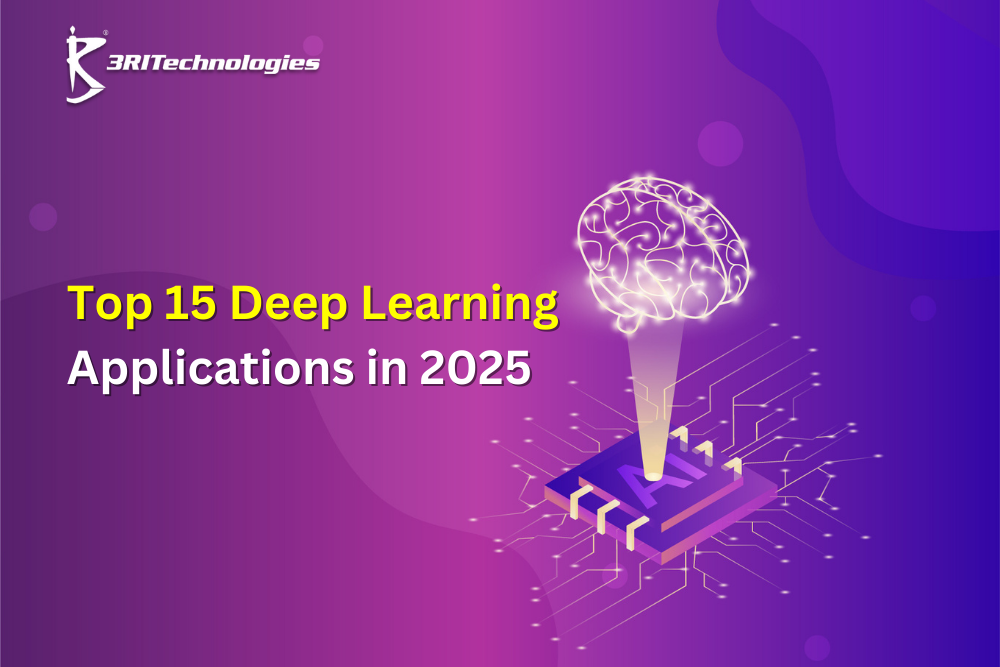Introduction to Deep Learning
Deep learning, a kind of machine learning, has revolutionized a number of industries by enabling computers to learn from massive amounts of data with astonishing accuracy. Deep learning algorithms are used in the healthcare industry to evaluate medical pictures and help with early disease diagnosis and detection. For example, they may spot cancers in radiology scans. These algorithms drive fraud detection systems in the financial industry, examining transaction patterns to identify irregularities instantly and boosting security and confidence.
These groundbreaking applications are just the beginning and are being built by highly skilled professionals. To learn what it takes to become the engineer who creates these systems, explore our comprehensive guide on how to build a successful career in AI.
In 2025, deep learning applications are revolutionizing industries with real-time insights and intelligent automation. From autonomous language learning to predictive healthcare, the top deep learning models are shaping the future of AI like never before. This article explores the top 15 use cases set to dominate the tech landscape. If you aspire to build a career in AI and machine learning, now is the time to act. Get hands-on training with our Machine Learning Classes in Pune at 3RI Technologies—your gateway to mastering deep learning and driving innovation.
Deep learning has the potential to further revolutionize businesses as research progresses, spurring efficiency and creativity in a variety of fields.
Emerging Use Cases, Models, and Trends in Deep Learning
Deep learning algorithms are designed to use multilayer neural networks to automatically learn from vast volumes of data. Here are some of the most commonly used deep learning algorithms
Types of Transformers
Transformers use attention techniques to process input in parallel rather than sequentially, and were first developed for natural language processing applications. They now serve as the basis for numerous cutting-edge models, such as BERT and GPT.
DBNs, or deep belief networks:
These are generative models made up of several latent, stochastic variable layers. DBNs are helpful for feature extraction and dimensionality reduction because they can learn to represent data hierarchically.
GANs, or Generative Adversarial Networks:
GANs, which are made up of two neural networks—a discriminator and a generator—are used to produce realistic synthetic data. They can be used for producing images, making videos, and improving training data.

Autoencoders:
These unsupervised learning methods are applied to tasks like denoising and data compression. By first compressing incoming data and then decoding it once again, autoencoders create useful data representations.
RNNs, or recurrent neural networks:
RNNs are especially helpful in time series prediction and natural language processing because they are made for sequential data. They are appropriate for tasks like speech recognition and language translation because they retain a recollection of prior inputs.
Networks with Long Short-Term Memory (LSTM):
One type of RNN that is particularly good at spotting long-term dependencies is called an LSTM. They are widely used in applications requiring time series data and natural language because they effectively handle the vanishing gradient problem.
CNNs, or convolutional neural networks:
CNNs are mostly used for image processing, and they perform well in tasks including object detection, facial recognition, and picture classification. To capture spatial hierarchy in images, they employ convolutional layers.
Deep Learning vs. Machine Learning
| Aspect | Machine Learning | Deep Learning |
| Definition | a branch of artificial intelligence that focuses on data-driven algorithms. | An application of multi-layer neural networks in machine learning |
| Feature Engineering | frequently necessitates feature extraction by hand. | Features are automatically extracted from unprocessed data. |
| Computation | less demanding on computation. | demands a large amount of processing power, frequently from GPUs. |
| Interpretability | frequently easier to understand (e.g., decision trees). | frequently easier to understand (e.g., decision trees). |
| Data Requirements | able to function with fewer datasets. | need a large amount of data for effective training.. |
| Model Complexity | simpler models in general (e.g., SVM, decision trees). | more intricate models with numerous parameters, such as CNNs and RNNs. |
| Training Time | usually quicker to train. | longer training periods as a result of intricate architectures. |
| Applications | suited for tasks involving classical data analysis. | Ideal for challenging tasks like audio and picture recognition and natural language processing |
Top 15 Deep Learning Applications
1. Image Recognition
Image recognition is the process of utilizing deep learning algorithms to recognize items, persons, or scenes inside images. These algorithms use learnt features to classify and tag photos by analyzing pixel data.
Applications include social networking sites that automatically tag pals in pictures and security systems that identify trespassers.
2. Natural Language Processing (NLP)
Machines can comprehend and communicate with human language thanks to natural language processing, or NLP. NLP processes text using deep learning for tasks including sentiment analysis, text summarization, and language translation.
Applications that greatly improve human-machine communication in a variety of fields include chatbots for customer support, content creation, and automatic language translation systems.
3. Fraud Detection
Fraud detection has become more difficult as the banking and financial industries have gone digital. This highlights unusual activity, enabling the detection and prevention of fraud. Algorithms for fraud detection are particularly helpful in preventing fraud.
4. Autonomous Vehicles
Deep learning is essential to the development of autonomous cars because it allows them to sense and comprehend their environment. By utilizing sensor data from cameras and LiDAR to recognize objects, pedestrians, and road signs, these systems enable safe navigation.
With the goal of improving road safety and transportation system efficiency, this technology is essential for self-driving cars and will eventually change how people commute.

5. Medical Diagnosis
Deep learning algorithms are used in the medical area to help healthcare practitioners diagnose illnesses by analyzing patient data and medical imaging. These systems interpret MRIs, X-rays, and other imaging modalities to accurately identify anomalies like tumors or fractures.
6. Generative Adversarial Networks (GANs)
In Generative Adversarial Networks (GANs), two neural networks—a discriminator and a generator—compete with one another to create realistic synthetic data. The discriminator assesses the fresh data samples’ authenticity while the generator creates them.
The outputs produced by this method are of higher quality, which is useful in fields like data augmentation, video production, and image generation.
7. Time Series Prediction
Time series prediction, which is frequently used in economics, finance, and weather forecasting, entails estimating future values based on historical data. These systems help firms make decisions and plan by processing sequential data and producing precise predictions. Applications that greatly increase operational efficiency and strategic planning include stock price forecasting, retail demand forecasting, and energy consumption prediction.
8. Video Analysis
Video analysis processes and interprets video content in real time by using deep learning. These systems find use in content moderation, sports analytics, and surveillance by identifying and tracking objects, identifying actions, and deriving valuable insights.
Video analysis can improve user experiences, strengthen security, and automate monitoring activities.
9. Image Generation
Image generation is the process of producing new images using patterns discovered in preexisting datasets. Applications in art, design, and gaming are made possible by deep learning models—in particular, GANs—which are skilled at creating high-quality images.
Image generation has an impact on sectors like entertainment and advertising since it makes it possible to produce original material and cuts down on the amount of time needed for graphic design.
10. Chatbots and Virtual Assistants
Chatbots and virtual assistants employ deep learning to understand and effectively respond to user inquiries. In customer service, they are often used to enhance the user experience by offering 24/7 support. These apps may learn from interactions thanks to deep learning, which helps them improve over time and adjust to user preferences for more individualized support.
11. Robotics
Deep learning improves robotics by giving machines the ability to intelligently perceive and interact with their surroundings. Robots are able to detect objects, navigate environments, and carry out intricate activities on their own by analyzing sensor data.
Applications include everything from service robots in healthcare and hospitality to automation in manufacturing.
12. Game Playing (AI)
AI can now play and learn from video games better thanks to deep learning, which helps it create methods that exceed human gamers. These models can gradually get better by analyzing game data and adjusting to different situations. One notable example is AlphaGo, which won a game of Go against world champions.
13. Personalized Marketing
By using deep learning to examine consumer behavior, personalized marketing adjusts advertising and promotional tactics to suit each person’s tastes. These algorithms generate audience-resonant customized ads by analyzing user data from social media interactions, past purchases, and browsing patterns.
14. Climate Modeling
By evaluating intricate datasets to forecast environmental changes and climate change, deep learning supports climate modeling. These models are able to recognize trends and predict future circumstances by analyzing data from sensors, satellites, and historical documents. Applications include tracking variations in temperature, forecasting severe weather, and evaluating the effects on the environment.
15. Financial Market Analysis
Using historical data, deep learning is utilized in financial market analysis to forecast stock prices and assess market trends. These models can detect hazards and opportunities by examining trends in prices, trading volumes, and economic data.
Deep learning algorithms are used by investment organizations to improve decision-making, optimize portfolios, and create trading strategies.









